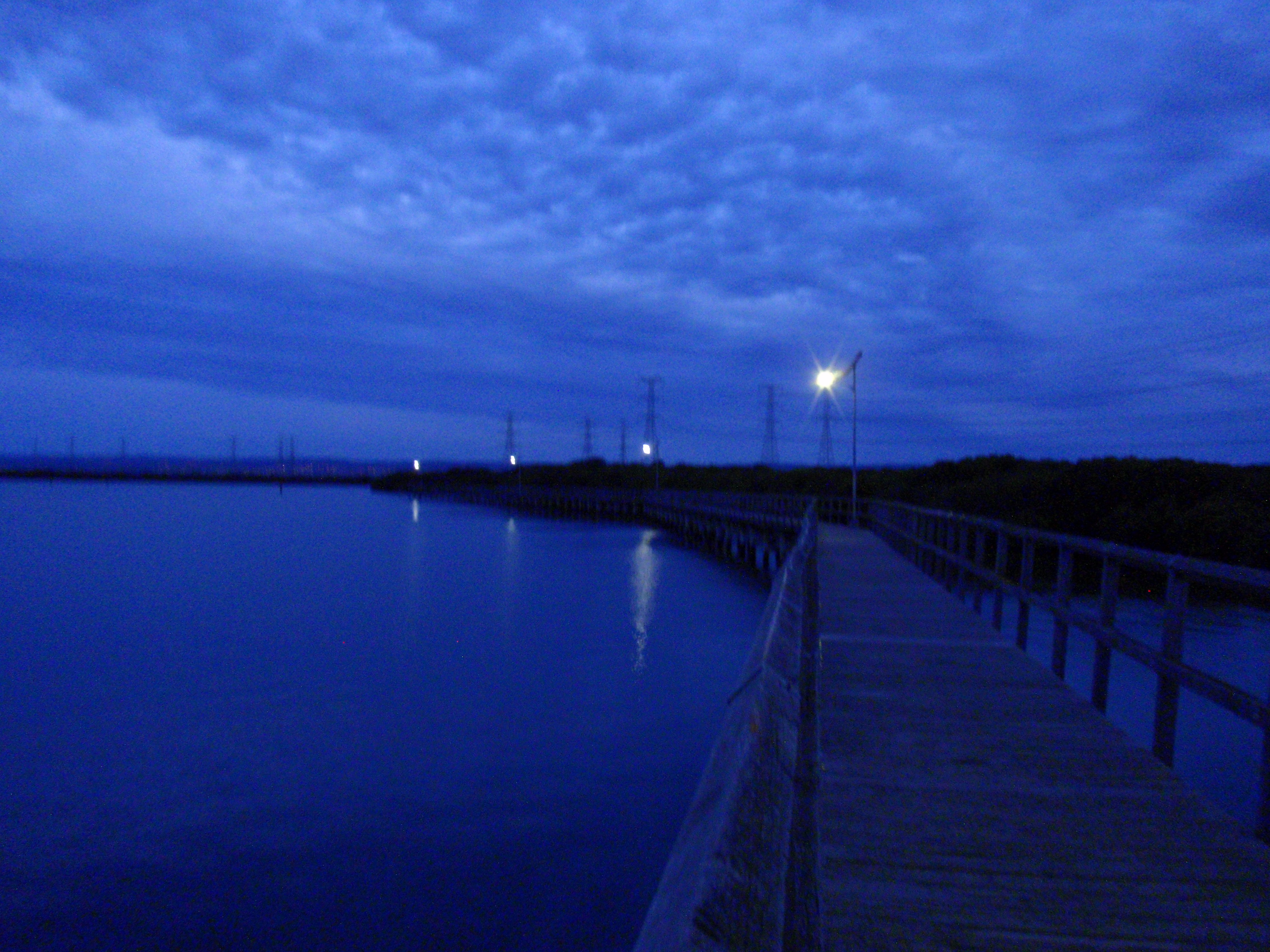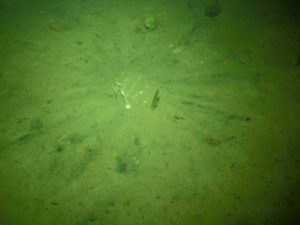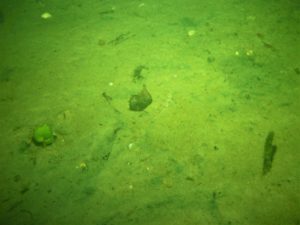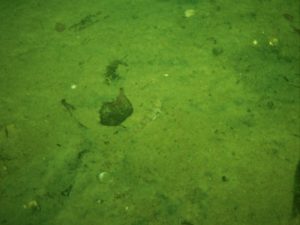“Sand ‘Spawning Sites’ ” by Steve Reynolds
I learned a bit about fish spawning sites over the Christmas/New Year break, after buying a DVD of Big Pacific with one of my birthday gift cards.
Big Pacific was a four-part TV series that aired in 2017. My DVD is a two-disc set which includes a “behind the scenes” chapter.
I was able to watch the first disc before Christmas. The first chapter on the disc featured footage of a single small pufferfish creating a large circular pattern in the sand on the sea bed. The creation of the pattern was hard work for the male puffer and it took him week to complete. The fish then left the area until a female puffer decided to hang around within the pattern. The male then approached the female and bit her side in order to have her release her eggs. She then swam away, leaving him to fertilize and care for the eggs.
I watched the second disc after Christmas. The “behind the scenes” chapter (Chapter 5) showed just how the footage of the pufferfish making the pattern in the sand was filmed. I was reminded that I had done a night snorkel in the mangroves at the Garden Island jetty (pictured above) at high tide a day or two earlier.
During my snorkel, I found a radiating pattern in the sand. It reminded me of the circular pattern created by the male pufferfish in Big Pacific. I took this photo of the radiating pattern in the gloomy conditions: –
I admit that this radiating pattern is nowhere near the complex pattern created by the male pufferfish in Big Pacific, but it has certainly aroused my interest.
I took another photo of a small fish close to the pattern: –
The fish is barely visible in the middle of this cropped image. Here is a further cropped image: –
I am not in a position to suggest that the fish was responsible for the radiating pattern in the sand, but I hope to be able to investigate the matter further.
A closer inspection of my first photograph reveals some kind of object in the middle of the radiating pattern. I wish that I had checked it out, but then I didn’t want to disturb it. It could well indicate the presence of a worm which may have created the radiating pattern. I will now keep an eye out for similar patterns in the sand.
In the meantime, I have searched the Internet for details about fish creating circular patterns. According to the web page found at https://www.livescience.com/40132-underwater-mystery-circles.html , “In 1995, divers noticed a beautiful, strange circular pattern on the seafloor off Japan, and soon after, more circles were discovered nearby. Some likened these formations to “underwater crop circles.” The geometric formations mysteriously came and went, and for more than a decade, nobody knew what made them.
“Finally, the creator of these remarkable formations was found: a newly discovered species of pufferfish. Further study showed these small pufferfish make the ornate circles to attract mates. Males laboriously flap their fins as they swim along the seafloor, resulting in disrupted sediment and amazing circular patterns. Although the fish are only about 12 centimetres (5 inches) long, the formations they make measure about 2 meters (7 feet) in diameter.
“When the circles are finished, females come to inspect them. If they like what they see, they reproduce with the males, said Hiroshi Kawase, the curator of the Coastal Branch of Natural History Museum and Institute in Chiba, Japan. But nobody knows exactly what the females are looking for in these circles or what traits they find desirable, Kawase told LiveScience.
“Pufferfish mating involves females laying eggs in the fine sediments in the center of the circles, and then the males fertilizing them externally. Then, the females vanish, and the males stay for another six days, perhaps to guard the eggs, the study noted.
“Males of some species of cichlids (a type of fish) are known to construct crater-shaped mounds that females visit to have their eggs fertilized, Kawase said. For example, male featherfin cichlids in Africa’s Lake Tanganyika build small bowls out of the sand, and display them to females before mating there, said Alex Jordan, a researcher at the University of Texas at Austin who wasn’t involved in this study.
“But this new pufferfish’s geometric patterns have three features never seen before. First, they involve radially aligned ridges and valleys outside the nest site. Second, the male decorates these ridges with fragments of shells. Third, the male gathers fine sediments to give the resulting formation a distinctive look and coloring, Kawase said.
“Strangely enough, the male “gathers” the fine sediments using the circular pattern itself, Kawase said. A fluid dynamics test using a half-size model of one of these circles found that the upstream portion of the circle funnels water and fine sediments toward the center. Then, the downstream peaks and valleys funnel the water outward. The speed of water was slowed by nearly 25 percent in the center, where the eggs are laid, the study noted.
“It takes about seven to nine days for the pufferfish to construct the circles. The male pufferfish don’t maintain these formations, and underwater currents wash them away relatively quickly. Kawase said they likely give up their old formations because the circles exhaust the fine sediment in the area, and thus must be built anew in areas with fresh sediment.
“When Jordan first heard about the circles, he guessed a much bigger fish would have made them. The fact that such a small animal makes such a large formation is “pretty cool, and suggests some underlying biological reason for the size, like poor visibility at depth, or distance between individuals that means males have to make large nests to be found by females,” he told LiveScience.
“Research describing the pufferfish formations was published in July in the journal Scientific Reports. “It’s a nice clean study because it provides a definite answer to the question — something that is very rare in biology,” Jordan said.
“The formations are very similar to so-called “bowers” — display sites built by various animals like bowerbirds in which to strut their stuff before mating. In this case, the formations may serve solely to gather fine sediments, which females could use to choose their mate, Jordan said.
“But until this idea is tested, nobody will know. “The one caveat I have is that there is no evidence that females care about anything more than the fine sand, and even that’s a stretch,” Jordan said. “The beautiful lines and structure could serve only to channel those particles to the center, and have no aesthetic purpose.”
“Although Jordan said he doesn’t think that’s the case, the idea that the fine sediments are important to females would be “biologically interesting, because it would suggest that function is more important than appearance,” he said.”
I found other web pages showing similar (identical?) scenes. The web page found at https://www.youtube.com/watch?v=yaPmYYWsixU stated, “little puffer fish capable of creating elaborately designed ‘crop circles’ at the bottom of the ocean as part of an elaborate mating ritual. The behavior was first documented by a photographer named Yoji Ookata who later returned with a film crew from the Japanese nature show NHK which later aired an episode about the fish. Even as articles bounced around the web it was still difficult to imagine how a tiny fish could create such a large design in the sand, even when staring directly at photographic evidence. Finally, video has emerged that shows just how the little guy delicately traverses the sand in a rotating criss-cross pattern to create a sort of subaquatic spirograph. The textured sand sculpture not only attracts mates but also serves as protection when the fish pair and lays eggs.”
There was some debate about the nature of the circular pattern. One person commented, “spawning circles are not a design so much as a spawning site that has to be prepared not only to attract the females but to successfully house the spawn and the fry after (they) hatch. To appreciate how such a spawning site would have evolved to its present complexity you’d also need to watch how the male puffer attracts his mate and the spawning act itself. That would show how fertilization takes place, how long it takes to happen and how the eggs are deposited. Then you also need to see how the eggs are tended, if they are tended and how the fry are raised. Most likely the furrows are individual spawning beds that are used over a period of time sequentially.”
There were further comments, such as “There is no mathematical perfection to the design. The design is driven by need. Most likely the designs become more elaborate as the male matures by virtue of the females choosing the mate and site she thinks fits her needs.”
And “Don’t for a minute suppose fish don’t think. They most certainly do and reason within the context of their lives. This site only appears amazing if you don’t have the benefit of the knowledge of the reproductive and rearing needs of the fish.”
Or “The fish is not intent on creating a design. It’s intent on building a tool that works to facilitate a sex act.”
Some images from Big Pacific can be found at https://image.tmdb.org/t/p/original/olENOMf2cd1LbxZ4gizUZjN32wU.jpg and https://image.tmdb.org/t/p/original/8WtErYHt5LFssc8RPRNciYuqW2r.jpg .
Further video footage can be found at:
https://www.livescience.com/63627-pufferfish-sand-art-video-reddit.html
https://www.bing.com/videos/search?q=David+Attenborough%27s+Natural+Curiosities%3a+Incredible+Shells&&view=detail&mid=D0D8878323BD0688FCD0D0D8878323BD0688FCD0&rvsmid=0DF6F868D30B15E3D9650DF6F868D30B15E3D965&FORM=VDQVAP – Japanese Puffer Fish (Excerpt from BBC Life Story)





I recall seeing similar circular patterns to the one you photographed, but back in 2017 when I first started exploring the Port River underwater. The patterns are quite subtle and difficult to photograph.